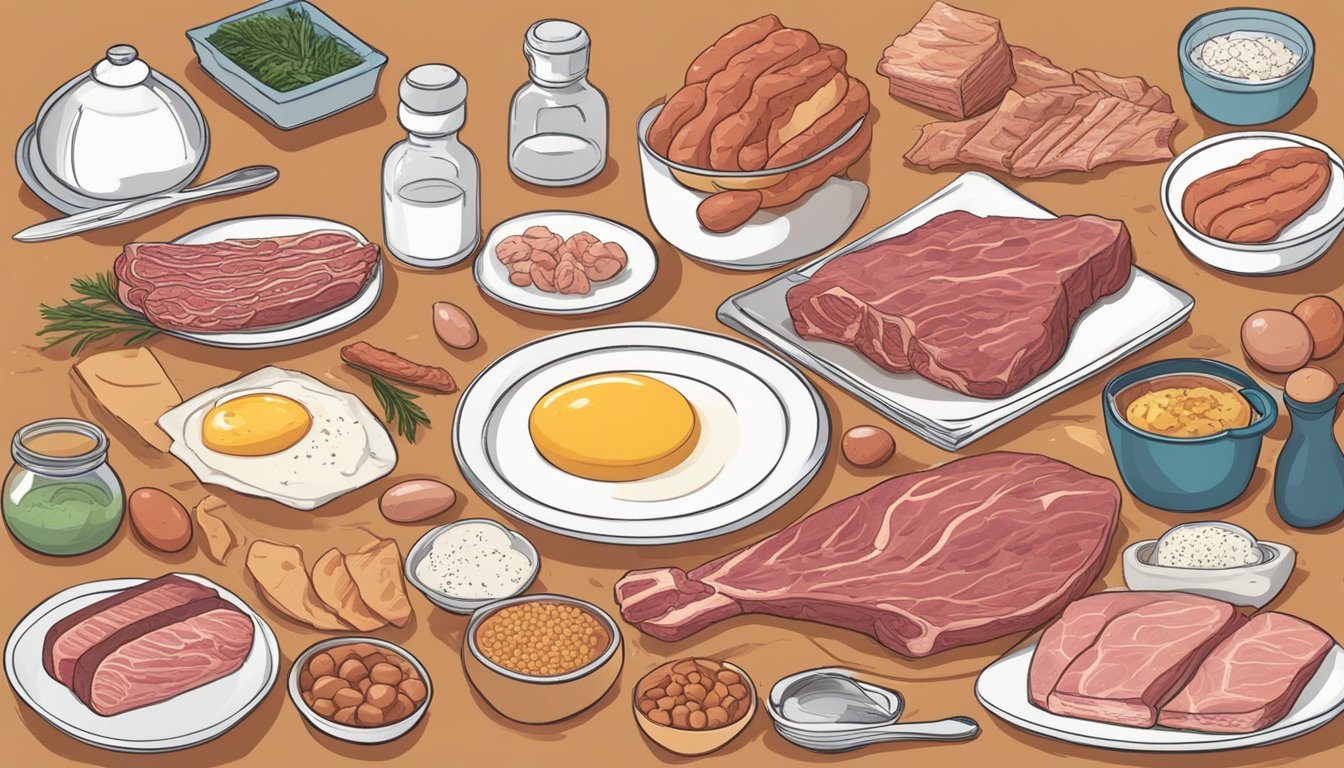Carnivore Diet First Week Symptoms
Navigating the Initial Transition
This Article is Part Of Our Guide on the Carnivore Diet
Embarking on a carnivore diet, a dietary regimen where one consumes exclusively animal products and other animal-based foods, entails a significant shift in nutritional intake that can lead to a variety of symptoms during the initial week. During the first few weeks, individuals may experience intense cravings for carbohydrates and sugar as their bodies adjust to the new source of energy. As individuals eliminate carbohydrates and plant fibers, and dramatically increase their intake of protein and fat, the body begins an adaptation process. This change in diet composition can cause noticeable changes in energy levels and digestive function as the body adjusts to the new sources of fuel.
These symptoms can manifest as digestive discomfort, including diarrhea or constipation, as well as general fatigue. The body may initially struggle with the absence of carbohydrates, leading to flu-like symptoms as it shifts to using fat as its primary energy source. During this period, it’s common for individuals to experience fluctuations in energy — often reporting low energy levels before a potential increase as their bodies become more efficient at utilizing fats.
For example, a typical bacon lunch can help meet protein requirements while avoiding cravings for non-animal products.
It is important to note that while these symptoms are prevalent during the adaptation phase, they typically subside as the body becomes accustomed to the new diet. The carnivore diet’s emphasis on high protein and fat seeks to provide sustained energy, and over time, many individuals report enhanced feelings of overall well-being once they’ve successfully adapted to the diet.
Introduction to the Carnivore Diet
The carnivore diet is a dietary regimen that involves consuming exclusively animal products, excluding plant-based foods. This diet has gained popularity in recent years due to its potential health benefits, including weight loss, improved mental health, and increased energy levels. However, like any other diet, it also has its side effects, which can be managed with proper planning and supervision. In this article, we will explore the carnivore diet, its benefits, and its side effects, as well as provide guidance on how to manage digestive issues and other concerns.
Understanding the Carnivore Diet
The Carnivore Diet emphasizes a high intake of animal products and the exclusion of plant-based foods. This diet advocates for consuming animal-based protein and fat as the primary source of nutrition. The carnivore diet benefits include potential improvements in weight loss, blood sugar control, and mood enhancement.
However, it is important to be aware of the carnivore diet side effects, such as digestive issues, nausea, and irritability, which can occur during the adaptation phase.
Defining the Diet
The Carnivore Diet is a restrictive regimen that focuses on eating solely animal products. Carnivore foods include nutrient-dense options like organ meats and fatty cuts of meat, which help with satiety. It is based on the premise that early humans thrived on a meat-dominated diet. Proponents suggest that this diet can lead to various health benefits, including weight loss and improved digestion. Ground beef is a common choice for its high protein content and versatility in meal preparation.
Foods to Consume
On the Carnivore Diet, individuals predominantly eat:
: Includes all types of meat such as beef, steak, pork, bacon, chicken, and ham.
Seafood: Encourages the consumption of fish like salmon and tuna.
Other Animal Products: This comprises eggs, cheese, butter, and cream.
These foods are believed to be the staples of a healthy and natural human diet by those following the diet.
Foods to Avoid
The diet strictly eliminates all plant-based foods. This includes, but is not limited to:
Fruits
Vegetables
Grains
Legumes
Nuts and Seeds
Any source of carbohydrates and fibers not derived from animal products.
By adhering to these principles, individuals on the Carnivore Diet aim to mirror a more ancestral pattern of eating, focusing on what they believe are more natural foods for human consumption.
Initial Physical Responses
During the first week of the carnivore diet, individuals typically experience several physical reactions as their bodies adjust to the new nutritional regime. These responses can include energy level changes, gastrointestinal shifts, and alterations in fluid and electrolyte balance, all of which are integral to the adaptation process. As the body transitions into ketosis, it begins burning fat for fuel, which can lead to changes in hydration levels and electrolyte balance.
Additionally, the elimination of carbohydrates can lead to lower blood sugar levels, which is beneficial for individuals with diabetes.
Energy Fluctuations
Adherents to the carnivore diet may report variable energy levels as their bodies transition into ketosis, a state where ketones become the primary energy source. This shift can lead to an initial phase of fatigue and headache, attributable to the body adapting to the absence of carbohydrates.
In the first few days, individuals may feel unusually tired as their bodies deplete glycogen stores.
Energy levels often stabilize and may even increase after this initial phase.
This shift also contributes to improved blood sugar control, particularly for individuals with type 2 diabetes.
Gastrointestinal Changes
Adjustments in digestion are common during the early stages of the carnivore diet. As individuals eliminate plant fibers and increase their fat intake, they might experience diarrhea** or constipation**
Diarrhea: The lack of fiber coupled with a significant increase in dietary fats can cause loose stools.
Constipation: Some individuals may find the reduction in fiber leads to less frequent bowel movements.
The body may also require increased production of digestive enzymes to effectively assimilate the higher fat intake.
Drinking bone broth can assist in soothing gastrointestinal symptoms by providing both hydration and nutrients.
Fluid and Electrolyte Balance
As the carnivore diet is often higher in protein and lower in carbohydrates, the body may excrete more water, leading to changes in hydration and electrolyte levels.
It's crucial to maintain adequate water intake to help mitigate symptoms of dehydration.
Individuals might need to increase their intake of salt and sodium to compensate for electrolyte loss.
Incorporating bone broth or electrolyte supplements can be beneficial in maintaining a balanced electrolyte status.
Managing Digestive Issues
Digestive issues are common during the initial transition phase of the carnivore diet. These issues can include constipation, diarrhea, and nausea, which can be alleviated by increasing salt intake, drinking plenty of water, and maintaining a balanced electrolyte balance. It is essential to listen to your body and adjust your diet accordingly. If you experience persistent digestive issues, it is recommended to consult with a healthcare professional.
Nutritional Considerations
During the first week of the carnivore diet, it is vital to understand macronutrient ratios, ensure adequate micronutrient intake, and maintain proper hydration and electrolyte levels to support the dietary transition.
Macronutrient Ratios
On the carnivore diet, macronutrients consist primarily of proteins and fats, with a negligible amount of carbohydrates. Individuals should aim for a high intake of protein to support muscle maintenance and satiety. Fats also play a crucial role, providing energy and helping with the absorption of fat-soluble vitamins. A typical macronutrient ratio on a carnivore diet might look like:
Protein: 60-70%
Fats: 30-40%
Carbohydrates: Less than 5%
Micronutrient Intake and Nutrient Deficiencies
While the carnivore diet can provide essential nutrients like iron, B vitamins, and zinc, there is a potential risk of deficiencies in micronutrients that are primarily found in plant foods, such as and certain antioxidants. Individuals should select a variety of meat cuts and organs to obtain a broad spectrum of nutrients. Incorporating organ meats can be particularly beneficial due to their dense micronutrient content.
Hydration and Mineral Needs
Adequate hydration is critical on the carnivore diet, as initial water loss is common when transitioning away from carbohydrates. The diet's diuretic effect necessitates increased water intake to prevent dehydration. Mineral needs, specifically electrolytes such as sodium, potassium, and magnesium, are also important to address. Magnesium citrate supplementation can help replenish magnesium levels. A simple hydration and electrolyte strategy:
Drink water to thirst, which may be more than usual.
Use salt liberally on meats to maintain sodium levels.
Consider a bone broth supplement to provide additional electrolytes.
Adaptation Symptoms and Management
When beginning a carnivore diet, individuals often experience a variety of adaptation symptoms as their body adjusts to significant dietary changes. It is important to note that highly restrictive eating patterns like the carnivore diet could trigger unhealthy behaviors in individuals with a history of eating disorders.
Managing these symptoms involves staying hydrated, ensuring adequate salt intake, and gradually transitioning into the diet. Like many other fad diets, the carnivore diet can promise quick results but may lack sustainability and lead to nutritional deficiencies.
Common Early Symptoms
Symptoms during the adaptation period can include:
Headachesbrain fog due to electrolyte imbalances or the body's initial struggle to switch from carbs to fat for fuel.
Fatigue and flu-like symptoms, sometimes referred to as the 'keto flu', are common as energy levels may fluctuate.
Digestive issues such as diarrhea and constipation can result from a lack of fiber or increased fat intake.
Cravings for carbohydrates often arise as the body transitions away from sugar reliance.
Individuals may also experience irritability and stress as part of the adjustment, as well as changes in sleep patterns.
Brain Fog and Fatigue
Brain fog and fatigue are common side effects of the carnivore diet, particularly during the initial transition phase. These symptoms can be caused by the body’s adaptation to the new diet, as well as potential nutrient deficiencies. To manage brain fog and fatigue, it is essential to ensure adequate intake of essential nutrients, such as vitamin C, and to stay hydrated by drinking plenty of water. Additionally, incorporating organ meats, such as liver and kidney, into your diet can provide beneficial nutrients and help alleviate these symptoms.
Managing the Transition
To manage these early symptoms, the following strategies can be beneficial:
Hydration: Drink plenty of water to help mitigate headaches and fatigue.
Electrolytes: Supplementing with sodium, potassium, and magnesium can alleviate flu-like symptoms.
Digestive Support: Supplements like ox bile and lipase can aid in fat digestion for those experiencing gastrointestinal discomfort.
Gradual Transition: Slowly reducing carbohydrate intake and increasing fat consumption can ease the body into new dietary changes, reducing the severity of symptoms.
Rest and Patience: Prioritizing sleep and allowing time for the body to adapt can help lessen irritability and stress.
Blood Pressure Considerations
The carnivore diet can have both positive and negative effects on blood pressure. On one hand, the diet’s emphasis on animal fats and protein can help lower blood pressure in some individuals. On the other hand, the high fat intake can increase blood pressure in others, particularly those with pre-existing health conditions. It is essential to monitor your blood pressure regularly and consult with a healthcare professional if you have concerns. Additionally, incorporating fatty fish, such as salmon, into your diet can provide beneficial omega-3 fatty acids and help lower blood pressure.
Potential Health Impacts
The initial week on the carnivore diet often triggers significant physical responses as the body adapts to a very high-protein, zero-carbohydrate intake. Individuals may experience changes in weight and digestive system reactions, among other effects. However, the high intake of saturated fats can increase the risk of heart disease and high blood pressure, particularly for individuals with pre-existing conditions.
The diet's impact on insulin levels can also affect sodium excretion by the kidneys, potentially leading to electrolyte imbalances.
Individuals with kidney disease should avoid the carnivore diet due to its high protein content, which could be too much for their kidneys to process.
Benefits and Mental Health
Weight Loss: Individuals on the carnivore diet may notice a reduction in weight during the first week. This can occur due to decreased inflammation and the absence of carbohydrates, leading to an initial loss of water weight.
Inflammation: The elimination of plant-based foods, which can sometimes cause sensitivities, may lead to reduced systemic inflammation.
Risks and Side Effects
Digestive Issues: A dramatic change in diet can lead to various digestive symptoms. Some people might experience diarrhea or constipation as their bodies adjust to the higher intake of meat and the absence of fiber.
Diarrhea
Constipation
Hydration and Electrolytes: The lack of carbohydrates can lead to a rapid decrease in water retention, possibly causing dehydration. Monitoring water intake and electrolyte balance is crucial to mitigate risks. Furthermore, the shift in electrolyte balance can induce muscle cramps or fatigue.
Dehydration
Electrolyte Imbalance
Cholesterol and Gallbladder: An increase in dietary cholesterol can affect cholesterol levels in the body. For those with pre-existing gallbladder issues, the high fat content might exacerbate symptoms.
Cholesterol Levels
Gallbladder Stress
Microbiome Changes: Removing plant fiber from the diet changes the gut microbiome, possibly reducing populations of beneficial bacteria, which in some cases may lead to unfavorable health outcomes.
Reduction in Beneficial Bacteria
Altered Microbiome Balance
Individuals with pre-existing health conditions should approach the carnivore diet cautiously and consider seeking medical advice to ensure the diet aligns with their health needs and that they properly manage potential side effects.
Long-Term Dietary Considerations
When considering the carnivore diet for an extended period, one must take into account the necessity for maintaining a balanced approach to nutrition, the potential need for dietary diversification, and the importance of regular health monitoring. Similar to the ketogenic diet, the carnivore diet can help individuals lose weight by significantly reducing carbohydrate intake.
Low carb diets like the carnivore diet can lead to drops in insulin levels, which subsequently causes the kidneys to excrete more sodium. This diet regiment is also known to lower blood sugar levels, making it a viable option for diabetes management. But, like many other fad diets, the carnivore diet can lead to nutritional deficiencies and may not be sustainable in the long term.
If you’re planning to give this nutritional regimen a try, tailored meal plans are essential to ensure that individual needs and goals are met while following the carnivore diet. You should be aware that the exclusion of other food groups such as carbohydrates, fruits, and vegetables can lead to potential nutrient deficiencies.
It’s also important to remember to avoid processed foods (just because they’re meat) is crucial to maintain a healthy balance of nutrients and avoid excessive salt intake. If you are able to keep a keen balance on your nutrient intake, the carnivore diet can promote weight loss by encouraging the body to burn fat for energy.
Sustaining the Carnivore Diet
Sustaining a carnivore diet long-term requires careful attention to nutrient intake to ensure the body gets everything it needs. Dieticians often debate the absence of carbs, fiber, and certain vitamins found in fruit, vegetables, and whole grains. While the body can adapt to utilize fats and proteins as primary energy sources, the total exclusion of other food groups may lead to deficiencies. Individuals may consider including organ meats, which provide a broader range of nutrients not found in muscle meats.
Diversification and Balance
While the carnivore diet is heavily meat-centric, diversification within the diet can be beneficial. Including different types of meats such as beef, lamb, pork, and fish can provide a variety of fats and proteins. Even within a strict carnivore framework, it's possible to introduce balance. For example, eating fish supplies omega-3 fatty acids, which might not be as prevalent in red meats. For some, the strategic introduction of non-meat items like nuts or a limited range of vegetables can address potential gaps in micronutrients without significant shifts in the meal plan.
Monitoring Health Markers
Regular health monitoring is vital for individuals on the carnivore diet, especially considering potential weight fluctuations and changes in biomarkers. Blood tests should be conducted to monitor glucose, cortisol levels, and other important health markers. Individuals with pre-existing conditions, such as arthritis or diabetes, should monitor their symptoms closely. Some proponents claim that a carnivore diet can help in reducing inflammation, potentially aiding in weight loss and mitigating the symptoms of autoimmune diseases. However, one must approach such claims with caution and consult a healthcare provider for personalized advice and monitoring.
Personalizing Your Carnivore Diet
When an individual embarks on a carnivore diet, personalization is key to accommodating their unique appetite and cravings, while ensuring a smooth transition. Unlike the more inclusive paleo diet which allows for plant-based foods like sweet potatoes, the carnivore diet restricts one to animal products. Tailoring the menu requires a balance of protein intake and fat intake — an essential step to satisfy hunger and support the body's metabolic process.
Protein Intake:
She should focus on a variety of meats to keep meals interesting and to provide a broad spectrum of nutrients. A daily guideline might look like:
Breakfast: Eggs and bacon
Lunch: Steak or roast beef
Dinner: Fish or chicken
Fat Intake:
Incorporating different fats is important for energy and satiety. She might consider:
Butter or ghee (how long does ghee last?) for cooking
Cheese as a snack
Fatty cuts of meat for main courses
Regarding exercise, someone on a carnivore diet might need to adjust their intake based on activity levels. Individuals who exercise heavily require more energy, hence a higher intake of both fat and protein may be necessary.
For those transitioning from a diet that includes plant-based foods, initial cravings for carbs are normal. Instead of reaching for sweet potatoes or other paleo-friendly carbs, one must focus on the allowed foods until the cravings subside.
People with specific health considerations, like ADHD, report different dietary impacts. While some find improvements in focus and clarity, others might not see the same benefits. This highlights the importance of monitoring one's reactions to the diet and making adjustments as necessary.
Individuals should also be mindful of their bodies’ signals. If they find themselves constantly feeling hungry, they may need to increase their overall food intake. Monitoring and adjusting are crucial as one's body adapts to this way of eating.





